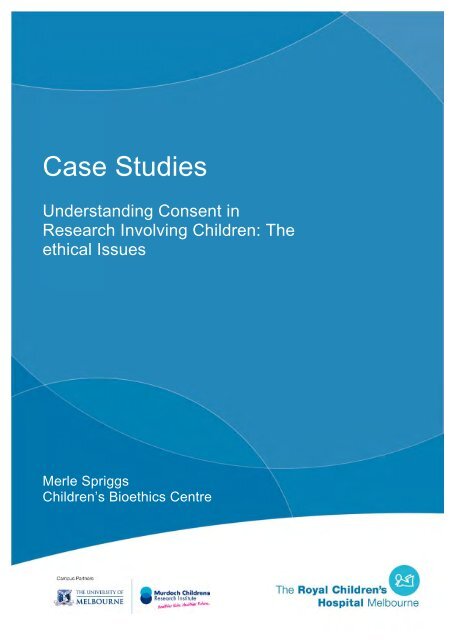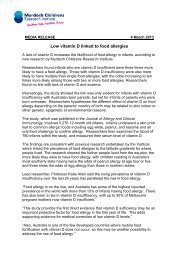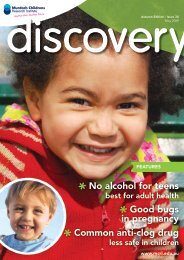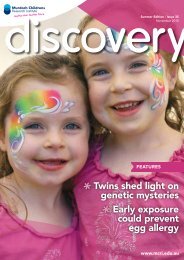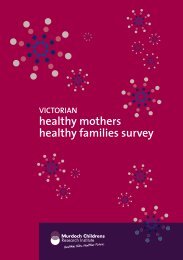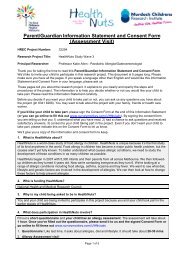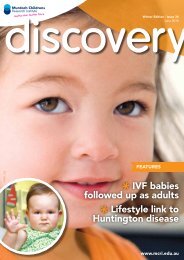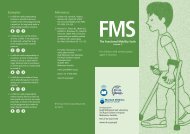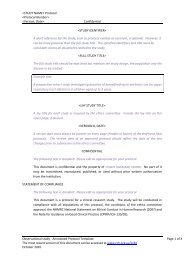Case Studies - Murdoch Childrens Research Institute
Case Studies - Murdoch Childrens Research Institute
Case Studies - Murdoch Childrens Research Institute
You also want an ePaper? Increase the reach of your titles
YUMPU automatically turns print PDFs into web optimized ePapers that Google loves.
<strong>Case</strong> <strong>Studies</strong><br />
Understanding Consent in<br />
<strong>Research</strong> Involving Children: The<br />
ethical Issues<br />
Merle Spriggs<br />
Children’s Bioethics Centre
<strong>Research</strong> Team<br />
Lead Investigator: Dr Merle Spriggs<br />
Children's Bioethics Centre<br />
<strong>Murdoch</strong> <strong>Childrens</strong> <strong>Research</strong> <strong>Institute</strong><br />
PO BOX 911<br />
Parkville, Vic. 3052, Australia.<br />
Phone: +61 3 9090 5237<br />
Email: merle.spriggs@mcri.edu.au<br />
Website: http://www.mcri.edu.au/projects/ConsentIn<strong>Research</strong>/<br />
Co-investigators: Associate Professor Lynn Gillam; Professor Colin Thomson;<br />
Associate Professor Justin Oakley<br />
Steering Committee: Dr Helen Liley; Professor Wendy Rogers; Assoc. Prof. Jane<br />
Halliday; Assoc. Prof. Sylvia Metcalfe; Dr Craig Olsson; Dr Catherine Lees; Dr<br />
Arnold Smith; Dr Lyndal Bond; Ms Malar Thiagarajan.<br />
Acknowledgments<br />
Thanks for the valuable input from:<br />
• Associate Professor Lynn Gillam<br />
• Professor Colin Thomson<br />
• Professor Wendy Rogers<br />
• Dr Judith Munro<br />
• Ms Alexandra Robertson<br />
• Dr Catherine Lees<br />
• Ms Georgina Hall<br />
This project is funded by a grant from the Alfred Felton Bequest which is managed by<br />
the ANZ Trustees<br />
Version 1 © Merle Spriggs 2009<br />
<strong>Case</strong> <strong>Studies</strong> - 1 -
Table of Contents<br />
<strong>Research</strong> Team 1<br />
Acknowledgments 1<br />
Purpose of this Resource 3<br />
CASE 1 4<br />
Adolescent invited to take part in research without parental consent: Consent<br />
to research versus consent for other activities.<br />
CASE 2 5<br />
Consent issues in research involving MySpace<br />
CASE 3 6<br />
Unobtrusive observation: <strong>Research</strong> involving an on-line support group<br />
CASE 4 7<br />
Opt-out consent and the role of parental consent in a study in a child care<br />
centre.<br />
CASE 5 8<br />
<strong>Research</strong> involving infants: Risky research and the framing of risk.<br />
<strong>Case</strong> <strong>Studies</strong> - 2 -
Purpose of this Resource<br />
This resource provides guidance on thinking through ethical issues in research<br />
involving children and young people and presents some models for best practice.<br />
Some cases will be easy and some will be hard. It is intended that there will be some<br />
contrasts.<br />
The cases could be used for training Human <strong>Research</strong> Ethics Committees (HRECs)<br />
and in research ethics education for researchers who are going to conduct research<br />
with children.<br />
Some cases are real, some are based on real life cases and some are fictitious.<br />
They are labelled accordingly.<br />
<strong>Case</strong>s are designed to raise issues for deliberation by Human <strong>Research</strong> Ethics<br />
Committees and researchers in situations in which they have not found sufficiently<br />
clear guidance in the National Statement. Any guidance provided in this resource is<br />
meant to build on the National Statement.<br />
We welcome new case studies to add to this resource. To add a case, email<br />
merle.spriggs@mcri.edu.au<br />
Note –The term “assent” is not used in the National Statement, but it is widely<br />
referred to in the research community and it is established in the literature. We use<br />
the term here to signify the role for children that lies between no involvement in<br />
discussions and full decisional authority. 1<br />
1<br />
M. Spriggs & L. Gillam. (2008). Consent in paediatric research: An evaluation of the guidance provided in the<br />
2007 NHMRC National Statement on Ethical Conduct in Human <strong>Research</strong>. Medical Journal of Australia.<br />
188(6): 360-362.<br />
<strong>Case</strong> <strong>Studies</strong> - 3 -
CASE 1<br />
[Fictitious case]<br />
Adolescent invited to take part in research without<br />
parental consent: Consent to research versus consent<br />
for other activities.<br />
A 14-year-old youth suffering depression does not want to discuss his problems with<br />
his parents. He seeks help from a community health centre. On his first visit he is<br />
provided with counselling and asked to return for a second visit where the possibility<br />
of medication will be discussed. He is reassured that his parents do not have to be<br />
involved if he does not want them to be. <strong>Research</strong>ers from the centre are looking for<br />
people to take part in a study that will find out if a new investigational drug can help<br />
in the treatment of depression. They invite the fourteen year old to participate in the<br />
randomised controlled trial. The researchers say that parental consent is not needed<br />
for the 14-year-old to access treatment so they do not need to obtain parental<br />
consent for him to participate in the research.<br />
Questions:<br />
1. Is the researchers’ view correct<br />
2. Does it depend on the nature of the research<br />
<strong>Case</strong> <strong>Studies</strong> - 4 -
CASE 2<br />
[Fictitious case]<br />
Consent issues in research involving MySpace<br />
Sixteen-year-old Sophie has chosen the option to set her MySpace profile to public<br />
viewing. She has filled in the ‘about me’, and ‘I’d like to meet’ areas of her profile<br />
and has included requests to ‘E-mail me’. Her profile is intentionally constructed in<br />
the hope of receiving feedback from those who view it.<br />
A researcher is conducting a study on bullying at school and young people’s<br />
experience of it. He is recruiting and collecting data via the internet from children<br />
and young people aged 12 to 16. In the first stage of the study he proposes to<br />
collect data from what is posted on Sophie’s MySpace site without Sophie’s consent<br />
and without parental consent. In the second stage of the study, the researcher plans<br />
to post/email questions for Sophie to answer i.e. to generate new data. The<br />
researcher will sign up as Sophie’s friend and then, if accepted, will post questions<br />
for her to answer, without making clear that this is research.<br />
Questions:<br />
First stage of project:<br />
1. Is Human <strong>Research</strong> Ethics Committee (HREC) approval needed<br />
2. Can the researcher use content from Sophie’s MySpace profile without Sophie’s<br />
consent<br />
3. Can the researcher use the potentially identifiable content on the basis of<br />
Sophie’s consent alone without parental consent<br />
4. If parental consent is deemed necessary but logistically difficult to obtain, can the<br />
researcher wait for 15 months until Sophie turns 18 and then use the data without<br />
parental consent but with Sophie’s consent<br />
Second stage of project:<br />
5. For the second stage of the study, is Sophie’s electronic acceptance of the<br />
researcher as a ‘friend’ equivalent to consent Is it enough consent What<br />
should the researcher disclose<br />
6. Is parental consent needed for the second stage of the study<br />
<strong>Case</strong> <strong>Studies</strong> - 5 -
CASE 3<br />
[Based on real life case]<br />
Unobtrusive observation: <strong>Research</strong> involving an online<br />
support group<br />
A psychologist researching young people who engage in self-harming behaviours<br />
has chosen an online support group to obtain data. He has chosen a ‘pro-anorexia’<br />
online support group. Members of the group advise on how to become and remain<br />
anorexic. An important feature of the group is that it allows unguarded self-disclosure<br />
while offering anonymous support and acceptance amongst its members. The<br />
proposed study will provide health professionals with an ‘insight that may otherwise<br />
be unattainable’ and this insight ‘can contribute to the development of effective<br />
therapies and treatments’ for anorexia. 2 Unobtrusive, passive observation is the<br />
method chosen by the researcher in order to protect the group from disruption and to<br />
avoid interviewer bias. This method can be likened to eavesdropping on the on-line<br />
exchanges and the members of the group do not know that they are being observed<br />
and researched.<br />
Questions:<br />
1. When is unobtrusive observation on the internet without consent acceptable<br />
2. Does it depend on what sort of group it is<br />
3. If the researcher changes pseudonyms and paraphrases quotes, is this sufficient<br />
to avoid identification of individuals<br />
Further questions:<br />
4. If a researcher felt that the identity of individuals in a ‘pro-anorexia’ website<br />
support group need not be protected given that they promote harm to self and<br />
others, would this be relevant<br />
5. If the researcher felt that the members would be better served if the group was<br />
disrupted, is this relevant to the ethics of the research<br />
2<br />
Gavin, Rodham and Poyer, “The presentation of ‘Pro-Anorexia’ in online group interactions” 326. This case is<br />
based on a study about issues of identity in ‘pro-anorexia’ online group interactions.<br />
<strong>Case</strong> <strong>Studies</strong> - 6 -
CASE 4<br />
[Real life case]<br />
Opt-out consent and the role of parental consent in a<br />
study in a child care centre.<br />
An experiment designed to study the spread of germs in a U.S. child care centre was<br />
closed down after a parent complained that the experiment was done without<br />
consent. <strong>Research</strong>ers sprayed a solution containing DNA fragments of a plant virus<br />
on toys, doorknobs and other surfaces in a number of day-care centres to track the<br />
spread of germs. The purpose was to find more effective ways of controlling germs in<br />
a child-care setting. No health risk to the children was anticipated.<br />
The DNA-based “marker” solution was placed in one toddler classroom in each of 14<br />
day-care centres. “There were 249 children, 1 to 2 years old, in those classrooms.<br />
Hundreds more children were present in other areas of the day-care centres and<br />
potentially were exposed to the marker as it was spread.”<br />
A letter outlining the study was left with each child’s belongings but written consent<br />
was not sought until after the children had been exposed to the solution.<br />
<strong>Research</strong>ers then approached parents asking for permission to swab the children’s<br />
hands to see if the solution was present. According to one proponent of the study:<br />
“parents were given the opportunity to opt out of the experiment, but none did”. 3<br />
Questions:<br />
1. Is leaving a letter with the children’s belongings a good enough way of contacting<br />
parents<br />
2. Is opt-out consent from the first phase of the study ethically acceptable, or should<br />
it be opt-in<br />
3. Is the first phase of the study really ethically different from the second phase<br />
4. Was parental consent needed at all<br />
3<br />
Bill Sizemore. A study in ethics: A parent’s complaint shut down a germ-tracking medical experiment in local daycare<br />
centres and raised questions about researchers’ responsibility to get informed consent. The Virginian-Pilot, 3<br />
August, 2003.<br />
<strong>Case</strong> <strong>Studies</strong> - 7 -
CASE 5<br />
[Real life case]<br />
<strong>Research</strong> involving infants: Risky research and the<br />
framing of risk.<br />
Effect of exposure to 15% oxygen on breathing patterns and<br />
oxygen saturation in infants: interventional study.<br />
<strong>Research</strong>ers carried out a study investigating the response of healthy infants to<br />
airway hypoxia (low oxygen) after reports that two infants had died from sudden<br />
infant death syndrome (SIDS) after intercontinental flights. The study involved 34<br />
healthy infants. Most were recruited from an obstetric unit while 13 were recruited<br />
from families receiving support in caring for an infant after a previous infant had died<br />
from SIDS. During the course of the study four infants had severe falls in oxygen<br />
saturation. A finding from the study was that ‘exposure to airway hypoxia similar to<br />
that experienced during air travel or on holiday at high altitude may be harmful to<br />
some infants’.<br />
In response to the question of whether it was ethically justified to expose healthy<br />
infants to 15% oxygen, the researchers claim that “Many infants travelling on<br />
aeroplanes or to holidays at high altitude are exposed to similar or even more<br />
markedly reduced partial pressures of inspired oxygen. Yet this exposure is<br />
considered safe”.<br />
See the study and commentaries by an ethicist and the chair of the ethics<br />
committee that approved the research in BMJ 1998 vol. 316: 887-894<br />
[link to free access article - http://www.bmj.com/cgi/content/full/316/7135/887 ]<br />
Parkins K. J., Poets C. F., O'Brien L. M., Stebbens V. A. and Southall D. P.<br />
(1998). Effect of exposure to 15% oxygen on breathing patterns and oxygen<br />
saturation in infants: interventional study. BMJ 1998; 316: 887-891<br />
Julian Savulescu. (1998). Commentary: Safety of participants in non-therapeutic<br />
research must be ensured. BMJ 1998; 316: 891-892<br />
Vivian Hughes (1998). Commentary: Ethical approval of study was warranted.<br />
BMJ 1998; 316: 892-893<br />
Parkins K. J., Poets C. F., O'Brien L. M., Stebbens V. A. and Southall D. P.<br />
(1998). Authors' reply. BMJ 1998; 316: 893-894<br />
<strong>Case</strong> <strong>Studies</strong> - 8 -
Questions:<br />
1. Rather than talking about the small risk of sudden death, is it acceptable to<br />
describe the risks of participation as involving no more risk than what infants are<br />
exposed to if they were travelling on an aeroplane or taken on a holiday to an<br />
area of high altitude<br />
2. Is the study too risky for children i.e. parents shouldn’t be allowed to even be<br />
asked<br />
<strong>Case</strong> <strong>Studies</strong> - 9 -


